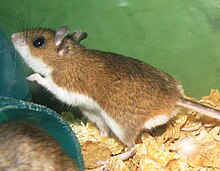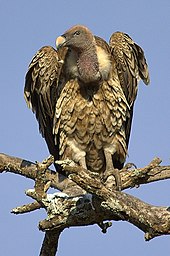Organisms at high altitude

Organisms can live at
Human populations such as some
High-altitude adaptations provide examples of convergent evolution, with adaptations occurring simultaneously on three continents. Tibetan humans and Tibetan domestic dogs share a genetic mutation in EPAS1, but it has not been seen in Andean humans.[3]
Invertebrates
Other invertebrates with high-altitude habitats are Euophrys omnisuperstes, a spider that lives in the Himalaya range at altitudes of up to 6,699 m (21,978 ft);[10] it feeds on stray insects that are blown up the mountain by the wind.[11] The springtail Hypogastrura nivicola (one of several insects called snow fleas) also lives in the Himalayas. It is active in the dead of winter, its blood containing a compound similar to antifreeze. Some allow themselves to become dehydrated instead, preventing the formation of ice crystals within their body.[12]
Insects can fly and kite at very high altitude.
Ballooning is a term used for the mechanical kiting[16][17] that many spiders, especially small species such as Erigone atra,[18] as well as certain mites and some caterpillars use to disperse through the air. Some spiders have been detected in atmospheric data balloons collecting air samples at slightly less than 5 km (16000 ft) above sea level.[19] It is the most common way for spiders to pioneer isolated islands and mountaintops.[20][21]
Fish
Fish at high altitudes have a lower metabolic rate, as has been shown in highland westslope cutthroat trout when compared to introduced lowland rainbow trout in the Oldman River basin.[22] There is also a general trend of smaller body sizes and lower species richness at high altitudes observed in aquatic invertebrates, likely due to lower oxygen partial pressures.[23][24][25] These factors may decrease productivity in high altitude habitats, meaning there will be less energy available for consumption, growth, and activity, which provides an advantage to fish with lower metabolic demands.[22]
The
Mammals

Rodents
A number of
Other physiological changes that occur in rodents at high altitude include increased
At high altitudes, some rodents even shift their thermal neutral zone so they may maintain normal basal metabolic rate at colder temperatures.[40]

The deer mouse (
Yaks

Among
Humans

Over 81 million people live permanently at high altitudes (>2,500 m (8,200 ft))[52] in North, Central and South America, East Africa, and Asia, and have flourished for millennia in the exceptionally high mountains, without any apparent complications.[53] For average human populations, a brief stay at these places can risk mountain sickness.[54] For the native highlanders, there are no adverse effects to staying at high altitude.
The physiological and genetic adaptations in native highlanders involve modification in the oxygen transport system of the blood, especially molecular changes in the structure and functions of hemoglobin, a protein for carrying oxygen in the body.[53][55] This is to compensate for the low oxygen environment. This adaptation is associated with developmental patterns such as high birth weight, increased lung volumes, increased breathing, and higher resting metabolism.[56][57]
The
Among the Andeans, there are no significant associations between EPAS1 or EGLN1 and hemoglobin concentration, indicating variation in the pattern of molecular adaptation.
The EPAS1 mutation in the Tibetan population has been linked to Denisovan-related populations.[66] The Tibetan haplotype is more similar to the Denisovan haplotype than any modern human haplotype. This mutation is seen at a high frequency in the Tibetan population, a low frequency in the Han population and is otherwise only seen in a sequenced Denisovan individual. This mutation must have been present before the Han and Tibetan populations diverged 2750 years ago.[66]
Birds

Birds have been especially successful at living at high altitudes.
Adaptation to high altitude has fascinated
The Andes is quite rich in bird diversity. TheCinnamon teal

Evidence for adaptation is best investigated among the Andean birds. The
Ground tits
In 2013, the molecular mechanism of high-altitude adaptation was elucidated in the Tibetan ground tit (
Other animals
Plants

Many different plant species live in the high-altitude environment. These include
The highest-altitude plant species is a
See also
References
- ^ PMID 21112992.)
{{cite journal}}: CS1 maint: multiple names: authors list (link - ISBN 978-0472095117.
- PMID 25091388.
- ^ Hogan, C.Michael (2010). "Extremophile". In Monosson, E; Cleveland, C (eds.). Encyclopedia of Earth. Washington, D.C.: National Council for Science and the Environment. Archived from the original on 2011-05-11.
- ^ Becquerel P. (1950). "La suspension de la vie au dessous de 1/20 K absolu par demagnetization adiabatique de l'alun de fer dans le vide les plus eléve". Comptes Rendus Hebdomadaires des Séances de l'Académie des Sciences (in French). 231: 261–263.
- ISSN 0362-4331.
- PMID 9558455.

- ^ Space.com Staff (8 September 2008). "Creature Survives Naked in Space". Space.com. Retrieved 2011-12-22.
- ^ Mustain, Andrea (22 December 2011). "Weird wildlife: The real land animals of Antarctica". NBC News. Retrieved 2011-12-22.
- JSTOR 1782885.
- ^ "Himalayan jumping spider". BBC Nature. Retrieved 2016-10-01.
- ^ Pearson, Gwen (14 January 2014). "Snow Fleas". Wired.
- ^ Mani, MS (1968). Ecology and Biogeography of High Altitude Insects. Springer. p. 118.
- .
- PMID 24501268.
- ^ "Flying Spiders over Texas! Coast to Coast". Archived from the original on 2011-11-26.
- ^ Maxim, Hiram Stevens (1908). "Flying Kites". Artificial and Natural Flight. p. 28.
- ^ Valerio, C.E. (1977). "Population structure in the spider Achaearranea Tepidariorum (Aranae, Theridiidae)" (PDF). The Journal of Arachnology. 3: 185–190. Retrieved 2009-07-18.
- ^ VanDyk, J.K. (2002–2009). "Entomology 201 - Introduction to insects". Department of Entomology, Iowa State University. Archived from the original on 8 June 2009. Retrieved 18 July 2009.
- doi:10.1071/IT01026. Retrieved 2009-07-18.
- ^ Bilsing, S.W. (May 1920). "Quantitative studies in the food of spiders" (PDF). The Ohio Journal of Science. 20 (7): 215–260. Retrieved 2009-07-18.
- ^ .
- S2CID 299377.
- PMID 14667371.
- S2CID 484645.
- PMID 18344480.
- S2CID 7459192.

- ISBN 978-1-4008-3411-2. Retrieved 2020-09-21.
- ^ a b c Canadian Broadcasting Company (CBC). "Wild China: The Tibetan Plateau". Archived from the original on November 13, 2012. Retrieved 2013-04-16.
- ^ China.org.cn. "Unique Species of Wild Animals on Qinghai-Tibet Plateau". Retrieved 2013-04-16.
- ^ a b WWF Global. "Tibetan Plateau Steppe". Archived from the original on 2013-06-15. Retrieved 2013-04-16.
- ^ Joshi LR. "High Altitude Adaptations". Archived from the original on 2014-01-06. Retrieved 2013-04-15.
- PMID 20639417.
- PMID 20811494.
- PMID 22586089.
- S2CID 9592507.

- S2CID 25131247.

- PMID 12562951.
- PMID 20174637.
- S2CID 35846450.
- PMID 3917990.
- S2CID 40735138.)
{{cite journal}}: CS1 maint: multiple names: authors list (link - PMID 19667207.)
{{cite journal}}: CS1 maint: multiple names: authors list (link - PMID 20639417.)
{{cite journal}}: CS1 maint: multiple names: authors list (link - PMID 23545644.)
{{cite journal}}: CS1 maint: multiple names: authors list (link - PMID 23219722.)
{{cite journal}}: CS1 maint: multiple names: authors list (link - ISBN 978-9251049655.
- PMID 16876112.
- ^ Shenzhen, BGI (July 4, 2012). "Yak genome provides new insights into high altitude adaptation". Retrieved 2013-04-16.
- PMID 22751099.
- PMID 23134687.
- PMID 33903258.
- ^ PMID 11443005.
- PMID 17339571.
- S2CID 33055072.
- PMID 21672719.
- S2CID 41726341.
- PMID 20595611.
- S2CID 45471238.
- PMID 21718161.
- PMID 22844521.
- S2CID 1900321.
- PMID 20838600.
- PMID 23236293.
- PMID 22264333.
- ^ PMID 25043035.
- S2CID 16820157.
- ^ "How the Respiratory System of Birds Works". Foster and Smith. Retrieved 21 December 2012.
- ISBN 978-0321501554.
- PMID 6624925.

- ^ Mathieu-Costello, O. (1990). Histology of flight: tissue and muscle gas exchange. In Hypoxia: The Adaptations. Toronto: B.C. Decker. pp. 13–19.
- PMID 2042973.

- ^ Swan, L.W. (1970). "Goose of the Himalayas". Journal of Natural History. 70: 68–75.
- ^ a b Tibet Environmental Watch (TEW). "Endemism on the Tibetan Plateau". Archived from the original on 2012-04-10. Retrieved 2013-04-16.
- ^ Conservation International. "Tropical Andes: Unique Biodiversity". Archived from the original on 2013-04-23. Retrieved 2013-04-16.
- ^ "How Do Birds Survive at High Altitudes?". The Wire. Retrieved 2021-01-27.
- S2CID 20755002.
- S2CID 8378355.
- PMID 23537097.
- ^ Facts and Details (of China) (2012). "Tibetan Animals". Retrieved 2013-04-16.
- ISBN 978-3-540-00347-2.
- ISBN 978-0-521-55986-7.
- ^ "High Altitude Plants". Adventurers and Scientists for Conservation. Archived from the original on 2012-04-25. Retrieved 2017-01-07.
- ^ Bezruchka, Stephen; Lyons, Alonzo (2011). Trekking Nepal: A Traveler's Guide. The Mountaineers Books. p. 275.
